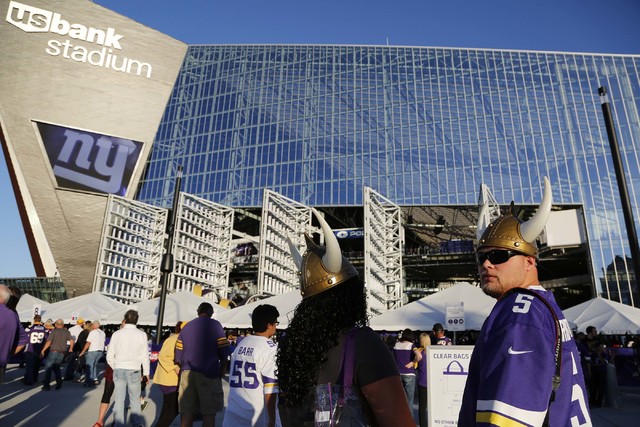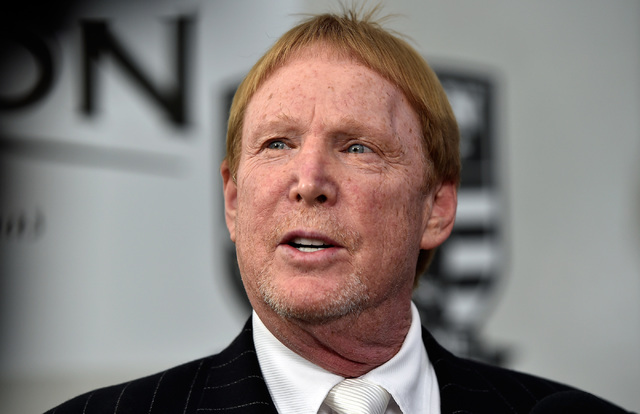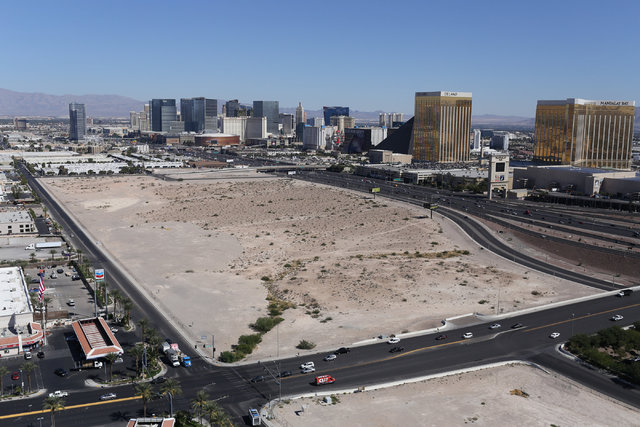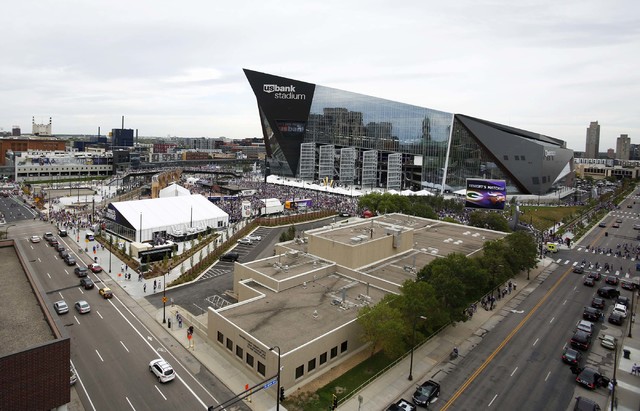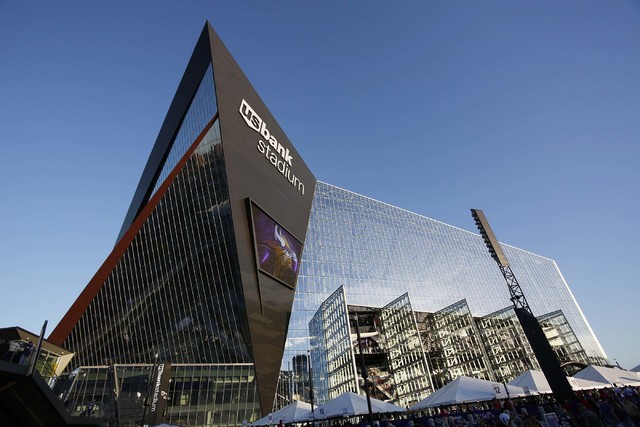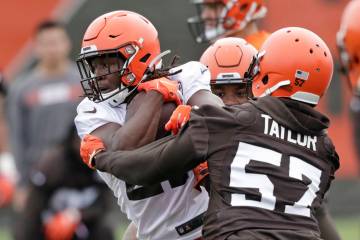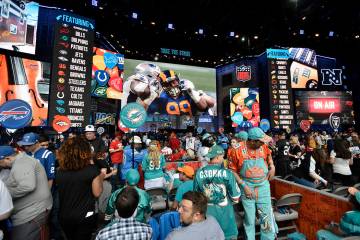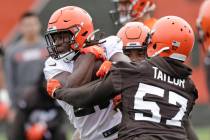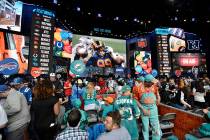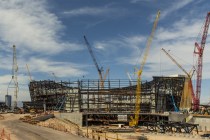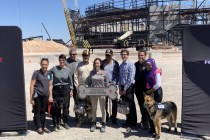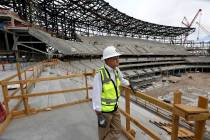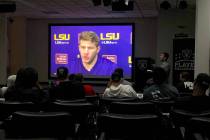Proposed Las Vegas stadium deal hinges on more than revenue from Raiders
The Oakland Raiders have long been one of the NFL’s poorest performing franchises — financially and on the football field.
Now, just as the team’s play is improving, the Raiders are poised to lift their fiscal fortunes. The franchise’s valuation already has jumped nearly 50 percent, based largely on a proposed 65,000-seat domed stadium in Las Vegas and the new revenue sources the venue will create.
“We want to have a home for the Raiders,” team owner Mark Davis said. “I think it’s such a unique opportunity in Las Vegas.”
Davis, along with key executives in the NFL’s front office, will be closely watching events in Carson City this week when the Nevada Legislature convenes a special session to consider public financing for a $1.9 billion stadium.
The terms of the deal — recommended unanimously Sept. 15 by the 11-member Southern Nevada Tourism Infrastructure Committee — require an increase in the Clark County hotel room tax to fund $750 million in construction and infrastructure; at least $650 million from the family of Las Vegas Sands Corp. Chairman Sheldon Adelson; and $500 million from the Raiders. The Adelsons would cover any cost overruns.
The financial commitment from the Raiders includes a $200 million loan from the NFL and $300 million that would be raised partially by the sale of personal seat licenses for the Las Vegas stadium.
If the Legislature approves the funding bill, the Raiders will ask NFL owners to vote to allow the team to move to Las Vegas.
But construction funding is only one part of the stadium plan lawmakers will examine this week. The deal hinges on the operating structure of the stadium, the dome attracting events besides NFL games, the revenues the stadium would generate and how that money is split.
RAIDERS REVENUES
The Raiders’ revenues from the new stadium are projected to hit $128.9 million in the first year of operations — likely in 2020 — and would stem primarily from the sale of suites, tickets, concessions, local media broadcast rights and stadium naming rights.
Jeremy Aguero, a principal analyst with Applied Analysis in Las Vegas, modeled the stadium revenue projections that were displayed at this summer’s SNTIC meetings and will be presented to the Legislature. The aggregate event revenue in the stadium’s first year is estimated at $263 million. Including nonevent revenue, such as naming rights, the total is close to $290 million.
How the revenues are shared among the Raiders, the Adelson family and the stadium operating company will be negotiated among those sides. After expenses, the net operating income — projected to be $20 million to $25 million in the first year — would be the return for the stadium developers. Aguero said it’s unclear if the NFL team would share in the money or if that would be the return for the Adelsons.
“That’s a relatively modest return on a $650 million investment,” Aguero said. “Are the developers going to get rich off of it? No.”
The No. 1 benefit for the Raiders, Aguero said, is “increase in value of the team.”
According to Forbes, the Oakland franchise’s estimated worth was approximately $1.43 billion last year, putting the Raiders in the league’s bottom five with Buffalo, Cincinnati, Detroit and the Rams, who experienced a major boost in value this year after relocating from St. Louis to Los Angeles.
In September, Forbes raised the Raiders’ franchise value by 47 percent to $2.1 billion — ranking 2oth in the league — due to the team’s anticipated move to a new stadium in Las Vegas or Los Angeles if the Nevada deal collapses.
NFL franchises comprise 27 of the 50 most valuable sports teams in the world, and the Dallas Cowboys rank first with a value of $4 billion. Cowboys Stadium was built through a public-private partnership and opened in 2009. The team granted stadium naming rights to AT&T in a sponsorship deal reported to be worth $17 million to $19 million per year.
MINNESOTA MODEL
The newest venue in the NFL is U.S. Bank Stadium in Minneapolis, a $1.1 billion facility for the Minnesota Vikings that opened this year. The financing model, which included $607 million from the team and private sources and $498 million from the state, closely resembles Las Vegas’ stadium plan.
Lester Bagley, the Vikings’ executive vice president of public affairs and stadium development, was instrumental in securing the deal for the team’s new home. Its former home, the Hubert H. Humphrey Metrodome, came with a lease that made the Vikings one of the league’s least lucrative teams.
“We were severely limited in terms of revenues. We were at the bottom of the league in every revenue category,” Bagley said. “To get off the bottom of every revenue chart, we needed a new stadium to resolve those issues.”
Under the NFL’s revenue sharing, the 32 teams evenly split around 60 percent of the money the league generates, and a player salary cap helps to ensure competitive balance. But state-of-the-art stadiums and practice facilities raise the profile of franchises and help attract and retain free-agent players. As part of the stadium financing deal in Las Vegas, $100 million would go toward the construction of a new practice facility for the Raiders.
As of now, the Raiders are perceived as a poor franchise that plays in the 50-year-old Oakland-Alameda County Coliseum, the only venue in the nation shared by an NFL and Major League Baseball team. The stadium has had problems with sewage backups, and the Raiders often play early-season games on the Oakland Athletics’ dirt infield.
The Metrodome, which opened in 1982, was similarly outdated. The Vikings received a $150 million loan from the NFL, and the team raised $125 million in personal seat licensing fees — referred to in Minnesota as a Stadium Builder’s License (SBL) — to help finance the new stadium’s construction. Of the $125 million raised through SBLs, $100 million went directly into stadium construction financing.
PSLs and SBLs are one-time fees that grant season ticket holders control of their seats for a defined term. License prices ranged from $500 to $9,500 for Minnesota fans, with an average price of $2,500. The Vikings, Bagley said, sold 49,000 seat licenses for the 66,655-seat stadium during what he called an “aggressive” three-year campaign.
“People stepped up to support the team and support the stadium because of its dynamic, progressive design,” Bagley said.
The team sold the stadium naming rights to U.S. Bank for a reported $220 million over 20 years. The Vikings receive 100 percent of that revenue, Bagley said, though he disputed the figure.
“It’s not as high as it’s been reported,” he said.
The latest Las Vegas stadium agreement, Aguero said, calls for 25 percent of stadium naming rights revenue to be allocated to the stadium operating company, with 75 percent allocated to the Raiders. But negotiations and terms of the deal are not cemented.
The Vikings are required to pay $8.5 million in yearly rent to U.S. Bank Stadium, which Bagley said is among the highest rent payments in the league. The Raiders’ rent payment for the Las Vegas stadium would be $3 million a year.
The Raiders’ 2016 lease at the Oakland Coliseum is $3.5 million, a dramatic increase over the $925,000 the team paid in 2015. The Oakland stadium has no naming rights sponsor, and the Raiders did not sell out the stadium’s 140 suites this season.
The rent payment for the UNLV football team, which would leave aging Sam Boyd Stadium, is undetermined at the new stadium.
“We say UNLV has a reasonable rent that needs to be determined by the stadium authority board as part of a lease agreement between the stadium developer and UNLV,” Aguero said. “The Raiders have absolute priority in terms of dates, but the Raiders guys were great in saying, ‘We want to make sure it works for UNLV.’”
All revenues from nonfootball events — concerts and soccer games, for example — go to the stadium operating company, and the Raiders would not control suites for special events. The deal is similar in Minnesota, where nonfootball revenues go to the stadium authority.
In Las Vegas, the stadium authority would be responsible for day-to-day operations, including maintenance, and oversee the booking of events and marketing efforts. A seven-member stadium authority board would be established, with the governor appointing the chairman.
The Las Vegas stadium, like U.S. Bank Stadium, would be owned by the public.
The Vikings’ stadium passed the Minnesota House and Senate in 2012, and Bagley called the public-private partnership a “successful deal” that has “created jobs and economic energy” and brought nearly $1 billion in additional development around the stadium, in addition to securing the Super Bowl in 2018 and the NCAA Final Four in 2019.
According to Forbes, the Vikings are the 18th most valuable NFL franchise at $1.6 billion, increasing 38 percent over the past year, and revenues from the new stadium could only brighten the team’s future.
“It doesn’t get us to the top of the NFL,” Bagley said, “but it gets us to a good position.”
‘ENORMOUS RISK’
Eight times a year — 10 times, including preseason games — the Las Vegas stadium would host NFL games. Add six UNLV games that would entertain smaller crowds. But when the Raiders and Rebels are not in action, what events are going to generate revenue?
“I don’t know how the stadium makes any money unless they can get a professional soccer team in there,” said Steve Sisolak, Clark County Commission chairman and a member of the SNTIC. “They will have to do a hell of a job promoting it. I credit the Sands people for taking an enormous risk.”
Adelson has committed his personal wealth to the stadium plan — not his company’s money — but Sands officials are representing Adelson in stadium negotiations. The Adelson side of the development team would cover any operating losses.
The stadium’s projected revenues, compiled by Applied Analysis, include $6.9 million from rugby, $18.8 million from neutral-site college football games and $14.7 million from concerts and other events that push first-year funds to $263 million.
In the future, the stadium could host a Super Bowl and NCAA Tournament games.
Aguero said he is using $360 million to $390 million as a “midpoint figure for the 30-year projection timeline” for annual stadium revenues.
“It’s fair, a little on the optimistic side,” Sisolak said, “but that can be exceeded if they are successful.”
Andy Abboud, Las Vegas Sands’ senior vice president of government relations and community development, said “understanding the big picture” is the main motive for wanting to build the stadium to attract the NFL and everything else that comes with it.
“It’s more than just an NFL stadium,” Abboud said. “It’s about expanding the entertainment options and expanding the visitor rates. It’s the economic velocity of the secondary spending. This is beneficial for the community, whether you are a football fan or not.
“It’s not a moneymaker for the developer; it’s a moneymaker for the community. We want to take the city to the next level.”
A new city and stadium that figures to provide a boost for the Raiders, who finally are winning on the field and stand to make up significant ground on the business end.
The Review-Journal is owned by the family of Las Vegas Sands Corp. Chairman and CEO Sheldon Adelson.
Contact reporter Matt Youmans at myoumans@reviewjournal.com or 702-387-2907. Follow on Twitter: @mattyoumans247
RELATED
Proposed $1.9 billion, 65,000-seat stadium in Las Vegas still has hurdles to clear
Las Vegas stadium, convention center expansion to get acid test in special session
Critics outline Raiders stadium objections, but Nevada casino group weighs in with support
Two Nevada groups announce opposition to proposed Raiders stadium in Las Vegas
Cowboys owner Jones urges aggressiveness in bringing Raiders to Las Vegas



